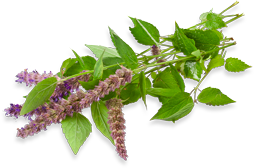חלק הצמח | איכויות | רכיבים פעילים | התוויות | מינונים | רגישות | תופעות לוואי |
מינון יתר | אזהרות | התוויות נגד | רעילות | אינטראקציות | הריון | הנקה
שם הסוג הבוטני נגזר מיוונית; לפי המיתולוגיה היוונית, הנימפה Menthe נהפכה לצמח.
שם המין נגזר מהמילה הלטינית piperitus, שמשמעותה ׳דמוי פלפל׳.
הנענע החריפה שמשמשת היום לרפואה הינה הכלאה עם שני מינים נוספים (M. spicata ו-M. aquatica). ההכלאה מצויינת על-ידי הוספת האות x בשמה הלטיני.
נענע חריפה הינה צמח רב-שנתי. נענע גדלה כיום ברחבי אירופה ואמריקה הצפונית.
נענע חריפה מותרת לשיווק בישראל.

חלק הצמח בשימוש
עלווה.
איכויות
טמפרטורה: חמים, עם אפקט משני קריר.
לחות: יבש.
טעם: מתקתק, חרפרף, ארומטי.
רכיבים פעילים עיקריים
שמן נדיף (0.5-4% מכלל הצמח, כולל 35-45% menthol, ו-10-30% menthone), מונוטרפנים: isomenthone (2–10%), 1,8-cineole (6–14%), a-pinene (1.0–1.5%), b-pinene (1–2%,
(limonene (1–5%), neomenthol (2.5–3.5% ו-menthofuran (בריכוז של 1-9%),
פלבונואידים (12% מכלל הצמח, כוללים גליקוזידים של apigenin, diosmetin, luteolin), טאנינים (6-12%) וחומרים מרירים.
הערה: מרבית החומרים הפעילים נמצאים בשמן הנדיף. לכן, חלק מן המטפלים מעדיפים שימוש בשמן הנדיף ולא בתמציות אחרות של נענע חריפה.
התוויות
שימוש פנימי – כאבי בטן, תסמונת המעי הרגיש (IBS), כאבי מחזור, בחילות, דיספפסיה, גזים.
שימוש חיצוני (שמן נדיף) – תסמונת המעי הרגיש (IBS), כאבי ראש, אסתמה (אינהלציה), ברונכיטיס אקוטית (אינהלציה), סינוסיטיס.
מינונים
תמצית נוזלית בריכוז 1:3, 45% אלכוהול – 3-6 מ״ל ביום.
חליטה – 6-12 גרם ביום.
בפורמולה – 25-30%.
שמן נדיף* – 0.15-0.6 מ״ל ביום (3-12 טיפות). אם כחלק מפורמולה של טינקטורות, אז בריכוז של 0.5-1% מכלל הפורמולה.
*אין להשתמש בשמן נדיף נענע חריפה לא מדולל.
רגישות
עלי נענע חריפה ובעיקר השמן הנדיף(1-7) עלולים לגרום ל למידע השלם למנויים
קיים דיווח מקרה בודד אודות גבר בן 69 ללא היסטוריה של אלרגיות או רגישויות למזונות או תרופות, שפיתח למידע השלם למנויים
תופעות לוואי
לא צפויות תופעות לוואי בנטילה פומית של עלי נענע חריפה(7);
רוב תופעות הלוואי הידועות מיוחסות לשימוש בשמן הנדיף או הרכיב menthol לבדו, לעיתים כחלק ממוצרי מזון.
תופעות אלו כוללות(9) למידע השלם למנויים
נטילה פומית של השמן הנדיף קושרה במספר מקרים ל למידע השלם למנויים
כמו כן, קיים דיווח(12) על החמרת למידע השלם למנויים
בליעת השמן הנדיף ללא ציפוי אנטרי עלולה לגרום ל למידע השלם למנויים
תופעות לוואי נדירות לשימוש כמוסות בעלות ציפוי אנטרי של השמן הנדיף(9,14) עלולות לכלול למידע השלם למנויים
נטילת כמוסות בעלות ציפוי אנטרי עלולה לגרום ל למידע השלם למנויים
מגע ישיר של השמן הנדיף עם הרקמות (ללא דילול) עלול לגרום ל למידע השלם למנויים
בקרב גברים טורקים שנוהגים לשתות 4 כוסות חליטת עלי נענע חריפה או Mentha spicata ביום, נצפתה למידע השלם למנויים
בעקבות הבחנה זו, נערך מחקר בו חולדות ממין זכר הושקו בחליטות נענע של המינים המדוברים. נצפתה למידע השלם למנויים
מינון יתר
על פי מקור בודד (משנת 1962, לא נגיש במלואו), צריכה מוגזמת של למידע השלם למנויים
מינון יתר שלהרכיב הפעיל menthol בשאיפה עלול לגרום ל למידע השלם למנויים
אזהרות וצעדי מנע
ריפלוקס, צָרבות ובקע סרעפתי – למידע השלם למנויים
רגישות לסליצילטים – למידע השלם למנויים
אבנים בכִיס המרה – למידע השלם למנויים
הפרדת נטילה – למידע השלם למנויים
תת חומציות בקיבה (היפוכלורידריה) – למידע השלם למנויים
תינוקות וילדים – למידע השלם למנויים
התוויות נגד
נענע חריפה אסורה לשימוש פנימי במצבים של למידע השלם למנויים
אין למרוח את השמן הנדיף ב למידע השלם למנויים
אינהלציה ו/או שימוש בטיפות אף של הרכיב הפעיל menthol עלולים לגרום ל למידע השלם למנויים
רעילות
הזרקה ורידית של השמן הנדיף (במינון לא ידוע) גרמה ל למידע השלם למנויים
כמו כן, צריכה פומית של השמן הנדיף במינון גבוה (לא ידוע כמה בדיוק) מקושרת להופעת למידע השלם למנויים
בקרב עכברים, נטילה פומית של תמצית נענע חריפה למידע השלם למנויים
חליטה של הצמח (בריכוז 1:5) שסופקה כמי השתיה של חולדות במשך 30 יום למידע השלם למנויים
לעומת זאת, נטילה פומית ממושכת של השמן הנדיף למידע השלם למנויים
במחקרים שונים שנערכו בחולדות נצפו למידע השלם למנויים
בקרב חולדות, נטילת שמן נדיף המכיל למידע השלם למנויים
מדד רעילות LD50: למידע השלם למנויים
תגובות הדדיות עם תרופות / צמחי מרפא / תוספי תזונה
השפעה על חילוף חומרים תרופתי למידע השלם למנויים
חוסמי תעלות סִידן (Felodipine) למידע השלם למנויים
נוגדי קרישה (Warfarin) למידע השלם למנויים
ניקוטין (סיגריות מנטול) למידע השלם למנויים
תרופות לדיכוי חיסוני (Cyclosporine) למידע השלם למנויים
תרופות הרגעה (ברביטוראטים, קודאין, Midazolam) למידע השלם למנויים
כימותרפיה למידע השלם למנויים
הריון
שימוש מוגבל בנשים אינו מעיד על נזק או רעילות בעקבות צריכת נענע חריפה בתקופה זו(7).
עם זאת, מקורות מסויימים טוענים כי יש למידע השלם למנויים
בבעלי חיים שונים לא נצפו כל השפעות למידע השלם למנויים
הנקה
נענע חריפה אפשרית לשימוש בהנקה, אולם יש לנקוט זהירות בתקופה זו(7).
בעוד השימוש בעלווה נחשב למידע השלם למנויים
קיים חשש שהשימוש בצמח למידע השלם למנויים
מקורות
- Tran A, Pratt M, DeKoven J. Acute allergic contact dermatitis of the lips from peppermint oil in a lip balm. Dermatitis. Apr 2010;21(2):111-115.
- Vermaat H, van Meurs T, Rustemeyer T, et al. Contact Dermatitis. 2008;58(6): 364–365.
- Dooms-Goossens A et al. Turpentine-induced hypersensitivity to peppermint oil. Contact Dermatitis, 1977, 3:304–308.
- Fisher A. Reactions to menthol. Cutis, 1986, 38:17–18.
- Saito F, Oka K. Allergic contact dermatitis due to peppermint oil. Skin Research, 1990, 32 (Suppl. 9): 161–167.
- Herro E, Jacob SE. Mentha piperita (peppermint). Dermatitis. 2010 Nov-Dec;21(6):327-9.
- Mills & Bone - Principles and practice of Phytotherapy. Modern Herbal Medicine, 2ed. Churchill Livingstone, 2013
- Bayat R, Borici-Mazi R. A case of anaphylaxis to peppermint. Allergy Asthma Clin Immunol. 2014 Jan 28;10(1):6.
- De Smet PAGM, Keller K, Hansel R, eds. Adverse Effects of Herbal Drugs, vol. 1. Berlin: Springer-Verlag; 1992. pp. 171–176.
- Morton CA, Garioch J, Todd P, et al. Contact Dermatitis. 1995;32(5): 281–284.
- Sainio EL, Kanerva L. Contact Dermatitis. 1995;33(2):100–105.
- Marlowe KF. Am J Health Syst Pharm. 2003;60(16):1657–1659.
- Somerville KW, Richmond CR, Bell GD. Br J Clin Pharmacol. 1984;18:638–640.
- Nash P, Gould SR, Barnardo DE. Br J Clin Pract. 1986;40(7):292–293.
- Pittler MH, Ernst E. Peppermint oil for irritable bowel syndrome: a critical review and metaanalysis.Am J Gastroenterol. Jul 1998;93(7):1131-1135.
- Opdyke DLJ. Food Cosmet Toxicol. 1976;14:471–472.
- C. F. Weston. Anal burning and peppermint oil. Postgrad Med J. 1987 Aug; 63(742): 717.
- Akdogan M, Ozguner M, Kocak A, et al. Effects of peppermint teas on plasma testosterone, follicle-stimulating hormone, and luteinizing hormone levels and testicular tissue in rats. Urology. 2004;64(2):394–398.
- Thomas JG. Lancet. 1962;1:222.
- Luke E. Lancet. 1962;1:110–111.
- Brinker F. Herb Contraindications and Drug Interactions, 4th ed. Sandy (OR): Eclectic Medical Publications; 2010
- Brooks S (ed.). Botanical toxicology. Protocol J. Bot. Med., 1(1):147-158, 1995
- Friedman G. Gastroenterol Clin North Am. 1991;20(2):313–324.
- Sigmund CJ, McNally EF. The action of a carminative on the lower esophageal sphincter. Gastroenterol., 56:13-18, 1969
- Bisset NG, ed. Herbal Drugs and Phytopharmaceuticals. Stuttgart: Medpharm Scientific; 1994. pp. 336–338.
- Wichtl M (ed.). Herbal Drugs and Phytopharmaceuticals. CRC Press, Boca Raton, 1994
- Blumenthal M, Busse WR, Goldberg A, et al. (eds). The Complete German Commission E Monographs: Therapeutic Guide to Herbal Medicines. Austin: American Botanical Council and Boston: Integrative Medicine Communications, 1998
- Hurrell RF, Reddy M, Cook JD. Inhibition of non-haem iron absorption in man by polyphenolic-containing beverages. Br. J. Nutr., 81:289-295, 1999
- Aetheroleum Menthae Piperitae. WHO Monographs on Selected Medicinal Plants. 2 vol. Geneva: World Health Organization; 2004:188-198.
- Rees WDW, Evans BK, Rhodes J. Treating irritable bowel syndrome with peppermint oil. British Medical Journal, 1979, 280:835–836.
- ESCOP monographs on the medicinal uses of plant drugs. Fascicule 3. Devon, European Scientific Cooperative on Phytotherapy, 1997.
- Owa JA. Acta Paediatr Scand. 1989;78:848–852.
- German Federal Minister of Justice. German Commission E for Human Medicine Monograph. Bundes-Anzeiger (German Federal Gazette); no. 50, dated 13.03.1986.
- De Smet PAGM et al. (eds.). Adverse Effects of Herb Drugs 2. Springer-Verlag, Berlin, 1993
- Reynolds JEF, ed. Martindale, the extra pharmacopoeia, 30th ed. London, Pharmaceutical Press, 1996.
- Lässig W, Graupner I, Leonhardt H, et al. Z Klin Med. 1990;45:969–971.
- Behrends M, Beiderlinden M, Peters J. Acute lung injury after peppermint oil injection. Anesth Analg. 2005 Oct;101(4):1160-2.
- Kligler B, Chaudhary S. Peppermint oil. Am Fam Physician. 2007 Apr 1;75(7):1027-30.
- Schulz V, Hänsel R, Tyler VE. Rational Phytotherapy: A Physician's Guide to Herbal Medicine. 3rd ed. New York, N.Y. :Springer, 1998.
- Della Loggia R, Tubaro A. Fitoterapia. 1990;61(3):215–221.
- Akdogan M, Kilinc I, Oncu M, et al. Hum Exp Toxicol. 2003;22(4):213–219.
- Akdogan M, Ozguner M, Aydin G, et al. Hum Exp Toxicol. 2004;23(1):21–28.
- Vo LT, Chan D, King RG. Clin Exp Pharmacol Physiol. 2003;30(10):799–804.
- Spindler P, Madsen C. Subchronic toxicity study of peppermint oil in rats. Toxicol Lett. 1992;62(2–3):215–220.
- Thorup I, Wurtzen G, Carstensen J, Olsen P. Short term toxicity study in rats dosed with peppermint oil.Toxicol Lett. Dec 1983;19(3):211-215.
- Mengs U, Stotzem CD. Med Sci Res. 1989;17:499–500.
- Nair B. Int J Toxicol. 2001;20(suppl 3): 61–73.
- Dresser GK, Wacher V, Wong S, et al. Evaluation of pepprmint oil and ascorbyl pallmitate as inhibitors of cytochrome P4503A4 activity in vitro and in vivo. Clin. Pharmacol. Ther., 72:247-255, 2002
- Goerg KJ, Spilker T. Aliment Pharmacol Ther. 2003;17(3):445–451.
- Holtmann G, Haag S, Adam B, et al. Phytomedicine. 2003;10(suppl 4): 56–57.
- Samojlik I, Petkovic S, Mimica-Dukic N, et al. Acute and chronic pretreatment with essential oil of peppermint (Mentha x piperita L., Lamiaceae) influences drug effects. Phytother. Res. [online prepub.; doi: 10.1002/ptr.3638], 2011
- Wacher VJ, Wong S, Wong HT. Peppermint oil enhances cyclospporine oral bioavailability in rats: comparison with d--tocopheryl poly(ethylene glycol 1000) succinate (TPGS) and ketoconazole. J. Pharm. Sci., 91(1):77-90, 2002
- Maliakal PP, Wanwimolrum S. Effect of herbal teas on hepatic drug metabolizing enzymes in rats. J. Pharm. Pharmacol., 53:1323-1329, 2001
- Gelal A, Balkan D, Ozzeybek D, et al. Effect of menthol on the pharmacokinetics and pharmacodynamics of felodipine in healthy subjects. Eur. J. Clin. Phamracol., 60:785-790, 2005.
- Coderre K, Faria C, Dyer E. Probable warfarin interaction with menthol cough drops. Pharmacother., 30:50e- 52e, 2010
- Kassebaum PJ, Shaw DL, Tomich DJ. Possible warfarin interaction with menthol cough drops. Ann. Pharmacother., 39:365-367, 2005
- Benowitz NL, Herrera B, Jacob P 3rd. Mentholated cigarette smoking inhibits nicotine metabolism. J Pharmacol Exp Ther. 2004 Sep;310(3):1208-15. Epub 2004 Apr 14.
- Ghazi AM, Salhab AS, Arafat TA, Irshaid YM. Effect of mint drink on metabolism of nicotine as measured by nicotine to cotinine ratio in urine of Jordanian smoking volunteers. Nicotine Tob Res. 2011 Aug;13(8):661-7. Epub 2011 Mar 31.
- Hukkanen J, Jacob P 3rd, Benowitz NL. Metabolism and disposition kinetics of nicotine. Pharmacol Rev. 2005 Mar;57(1):79-115.
- Nowack R, Nowak B. Herbal teas interfere with cyclosporin levels in renal transplant patients. Nephrol Dial Transplant. 2005 Nov;20(11):2554-6. Epub 2005 Jul 26.
- Brinker F. The Toxicology of Botanical Medicines, 3rd ed. Eclectic Medical Pub., Sandy, Ore., 2000
- Farnsworth NR, Bingel AS, Cordell GA, et al. Potential value of plants as sources of new antifertility agents I. J. Pharm. Sci., 64:535-598, 1975
- Fifty-first Meeting of the Joint FAO/WHO Expert Committee on Food Additives (JECFA). Safety Evaluation of Certain Food Additives. WHO Food Additives Series: 42. Geneva: WHO; 1999.
- Hosoda K, Matsuyama H, Park WY, et al. Anim Sci J. 2006;77(5):503–509.
- Unger M, Frank A. Simultaneous determination of the inhibitory potency of herbal extracts on the activity of six major cytochrome P450 enzymes using liquid chromatography/mass spectrometry and automated online extraction. Rapid Commun Mass Spectrom. 2004; 18:2273-2281.

דוגמא למונוגרף מלא
לרכישת מנוי |
כניסת מנויים






